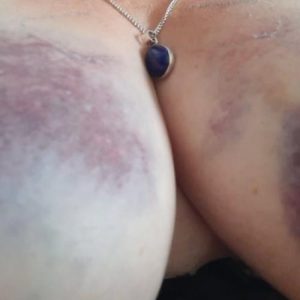Breast Injuries and it’s Consequences

Breast injuries in sports are often overlooked but crucial for athlete health and performance. These injuries, while usually not causing long-term damage, can be distressing and raise concerns about breast cancer, although such fears are often unfounded.
In sports, traumatic breast injuries are common, leading to discomfort, bruising, and swelling. These injuries, though not typically linked to cancer, can impact athletes’ performance. A significant number of elite female athletes report such injuries affecting their performance, yet seldom discuss them with professionals, underscoring the need for increased awareness and open discussions about breast health in sports.
Flat Armour or Female Formed Armour?
When comparing the impact of a collision on a breast that is squashed against armor versus one encapsulated in a breast cup armor, several key differences in the potential effects and protection levels are worth considering:
-
Squashed Breast Against Flat Armor:
- Increased Pressure Distribution: When the breast is squashed against flat armor during a collision, the impact force is distributed over a larger area. This can lead to more widespread bruising or trauma across the breast tissue.
- Higher Risk of Tissue Damage: The squashing effect can cause more significant damage to the breast tissue, potentially leading to issues like hematoma (a collection of blood outside of blood vessels) or tissue necrosis (death of tissue).
- Potential for Greater Discomfort: This arrangement is likely to be less comfortable, especially during high-impact activities, as the flat armor does not conform to the natural shape of the breast.
-
Breast Encapsulated in a Breast Cup Armor:
- Focused Impact Absorption: Breast cup armor is designed to encapsulate and conform to the shape of the breast, which can help absorb and distribute the impact more evenly. This design can reduce the risk of concentrated trauma to a specific area.
- Reduced Tissue Damage: The shape and fit of breast cup armor can provide better protection against severe tissue damage, as it is designed to accommodate the breast’s natural form and movement.
- Increased Comfort and Mobility: Breast cup armor is often more comfortable and allows for greater mobility, as it is designed to fit the natural shape of the body. This can be particularly important in sports or activities where movement and flexibility are crucial.
In summary, breast cup armor is generally more effective in protecting the breast from the impact of a collision. It offers a combination of comfort, mobility, and impact distribution that is superior to flat armor, which tends to distribute pressure less evenly and may cause more extensive tissue damage and discomfort.
Injuries with Breast Implants
When a woman with breast implants experiences a collision, several types of damage can occur to the implants and the surrounding breast tissue. The specific nature and severity of the damage depend on various factors, including the force of the collision, the type of implants, and their placement. Here are some potential types of damage:

- Rupture of the Implant: One of the most serious concerns is the rupture of the implant. This can happen in both saline and silicone implants. A rupture in a saline implant typically results in a noticeable deflation of the breast, as the saline solution leaks out. In silicone implants, a rupture might not be immediately obvious (silent rupture) and can sometimes only be detected through imaging tests like an MRI.
-
Capsular Contracture: This condition involves the hardening of the scar tissue (capsule) that naturally forms around the implant. A collision can aggravate this tissue, causing it to contract and squeeze the implant, potentially leading to pain and distortion in the shape of the breast.
-
Displacement or Movement: The impact from a collision can cause the implant to shift from its original position. This can result in asymmetry, where one breast looks different from the other, or the implant may move to an abnormal position within the breast.
-
Hematoma or Seroma Formation: Hematomas (blood collections) or seromas (fluid collections) can develop around the implant as a result of the trauma from the collision. These can cause swelling, pain, and discomfort.
-
Damage to Breast Tissue: Apart from the implants themselves, the breast tissue and surrounding areas can also be affected. This may include bruising, swelling, and in severe cases, tissue necrosis (death of tissue).
-
Pain and Sensitivity Changes: Women may experience increased pain, tenderness, or changes in sensation in the breast area following a collision.
In any case of a collision or trauma to the breast area, especially in women with breast implants, it is important to consult a healthcare professional for a thorough evaluation and appropriate management. They may recommend imaging studies and provide guidance on whether any intervention is required.
